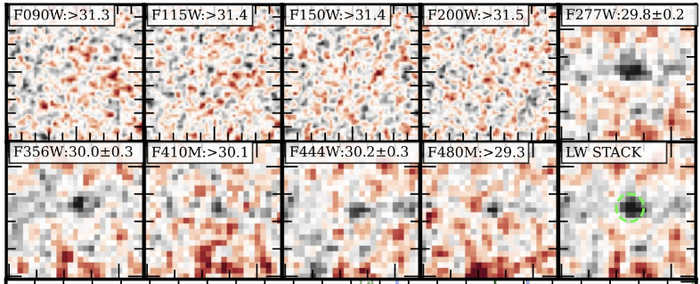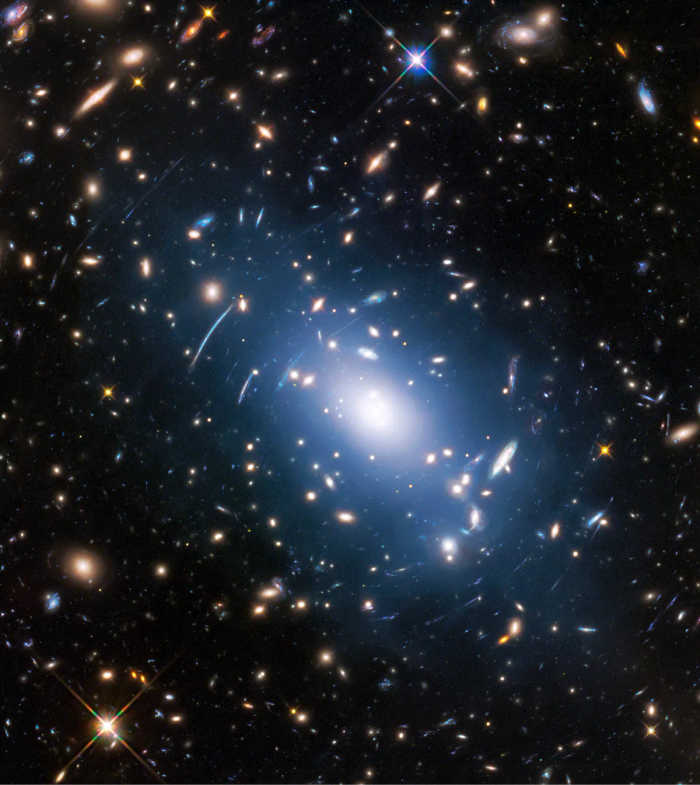Published 23:31 IST, November 26th 2024
JWST May Have Discovered the Earliest Galaxies Ever Seen, Pushing the Limits of Cosmic Discovery
James Webb Space Telescope may have discovered the earliest galaxies yet, seen just 200 million years after the Big Bang, potentially rewriting cosmic history.
- Science News
- 7 min read
The James Webb Space Telescope (JWST) has made an exciting new discovery that could rewrite our understanding of the early universe. Five candidate galaxies observed by the JWST may be the most distant galaxies ever detected, with light that traveled for 13.6 billion years to reach us.
These galaxies are seen as they existed just 200 million years after the Big Bang, making them potential candidates for the earliest galaxies in the universe. Though the discovery is not yet confirmed, it could provide crucial insights into the formation and evolution of galaxies in the first few hundred million years of cosmic history.
The longer light takes to reach us, the more pronounced the redshift it undergoes. The degree of redshift experienced by a galaxy is represented by "z" followed by an equals sign and a unitless number.
For example, a redshift of z = 0.10 indicates that the light has been traveling for 1.3 billion years and the galaxy is now 1.3 billion light-years away. A redshift of z = 1 means the light has journeyed for 7.7 billion years and, due to the expansion of the universe, the galaxy is now 10.1 billion light-years away. Meanwhile, a redshift of z = 10 corresponds to an object located about 26.6 billion light-years away, with its light having traveled for 13.2 billion years published in Cumbres University.
The Discovery: Five Candidate Galaxies
As part of the Galactic Legacy Infrared Midplane Survey Extraordinaire (GLIMPSE) project, the JWST identified five galaxy candidates located at incredible distances. These galaxies are so far away that their light has traveled for approximately 13.6 billion years to reach Earth. The light from these objects started its journey when the universe was only 200 million years old, just a fraction of its current age.
- Distant Galaxies: The most distant of these five candidate galaxies is located around 34 billion light-years away, as a result of the universe’s ongoing expansion.
- Redshift: These galaxies are characterized by extremely high redshifts—ranging from z = 16 to z = 18—meaning they have undergone significant stretching of their light waves due to the expansion of the universe. This makes them appear much redder than nearby galaxies.

This discovery, while still pending confirmation, could potentially make these galaxies the earliest ever observed, shedding light on the formation of the first stars and galaxies in the universe.
Context: Previous Discoveries by JWST
Before this discovery, the farthest galaxy observed by JWST was JADES-GS-z14-0, seen when the universe was around 280 million years old. These new potential discoveries surpass the earlier record, pushing the boundaries of what astronomers previously thought was possible to observe.
The names of these new galaxies will likely begin with the prefix GLIMPSE, in reference to the survey that uncovered them. However, further observations and data are needed before these galaxies can be officially confirmed as the earliest and most distant galaxies ever seen.
The Importance of This Discovery
The JWST’s ability to detect galaxies at such a high redshift brings scientists one step closer to understanding the formation of the first galaxies. These galaxies will help astronomers refine models of the universe's early history and the processes that allowed galaxies to form so soon after the Big Bang.

Hakim Atek, a researcher at the Paris Institute of Astrophysics and a member of the discovery team, notes the importance of these observations:
- Tight Constraints on Models: The discovery will help tighten the constraints on theoretical models about galaxy formation. With only 150 million years after the Big Bang available for galaxy formation, the team hopes to refine their understanding of how the universe's earliest galaxies were born.
Gravitational Lensing: A Key to Seeing the Past
One of the reasons JWST has been able to detect these faint, distant galaxies is the phenomenon of gravitational lensing. This is where massive objects, such as galaxy clusters, warp spacetime, bending the light of more distant objects behind them. In this case, the team used the Abell S1063 galaxy cluster, located about 4 billion light-years away, as a cosmic lens to magnify the distant galaxies.
- Einstein's Theory of Gravity: Gravitational lensing was first predicted by Albert Einstein in 1915 as part of his theory of general relativity. When light passes near a massive object like a galaxy cluster, the object’s gravitational field bends the light, acting like a lens.
- Magnification: The gravitational lensing effect allows astronomers to observe objects that would otherwise be too faint to see, making it a powerful tool for studying distant galaxies, especially in the early universe.
The JWST's use of gravitational lensing has been critical in the discovery of these early galaxies. Without it, these galaxies would likely remain undetected due to their extreme distance and faintness.
The Role of Redshift in Understanding Early Galaxies
The redshift of a galaxy is a key indicator of how far away it is and how early in the universe's history it formed. The higher the redshift, the farther away the galaxy is, and the more stretched out its light waves have become due to the expanding universe.
- Redshift Explained: In simple terms, redshift occurs when light from a distant galaxy stretches out as the universe expands. This shift toward the red end of the electromagnetic spectrum allows scientists to measure the galaxy’s distance from Earth.
- High Redshift Galaxies: Galaxies at redshifts between z = 10 and z = 14 are already being discovered routinely by the JWST. However, the five candidate galaxies identified in the GLIMPSE project have even higher redshifts of z = 16 to z = 18, making them potential candidates for some of the earliest galaxies ever observed.

The high redshifts of these galaxies suggest that they are among the youngest galaxies formed, potentially shortly after the first stars ignited in the universe.
Challenges of Detecting the Earliest Galaxies
Despite the JWST’s remarkable capabilities, detecting galaxies from the earliest stages of the universe remains a challenge. These early galaxies are not only incredibly distant but also intrinsically faint. Their faintness makes it difficult to discern their characteristics in detail, and astronomers require spectroscopic data to confirm their nature.
- Faint Galaxies: Even with gravitational lensing, the galaxies discovered in this study remain faint compared to other high-redshift galaxies observed by the JWST.
- The Need for Spectra: To understand these galaxies better, astronomers would need detailed spectra, which would allow them to study their composition, age, and other key characteristics. However, obtaining spectra from such faint sources is extremely challenging and may require longer observation times.
The Future of High-Redshift Galaxy Discoveries
The JWST has the potential to uncover even earlier galaxies, but this depends on a number of factors, including their luminosity, number, and density. The GLIMPSE project has already pushed the telescope to its observational limits, with the team having just 150 hours of observation time. Detecting even fainter and smaller galaxies would require a significant increase in observation time, possibly up to 450 hours.
- A Pushing the Limits: Team leader Vasily Kokorev from the University of Texas explained that detecting earlier galaxies would likely be very challenging, given the constraints of both the telescope and the observation time required.
- Possibility of Further Discoveries: While it is theoretically possible to find even earlier galaxies, these would be much harder to detect due to their faintness and small size. Even with the JWST’s capabilities, such discoveries would be extremely difficult.
Despite these challenges, the GLIMPSE project has already provided groundbreaking results, and more exciting discoveries are expected in the future.
Conclusion: A New Era in Cosmic Discovery
The potential discovery of the earliest galaxies ever observed marks an exciting chapter in our understanding of the universe’s infancy. The James Webb Space Telescope, aided by techniques like gravitational lensing, is pushing the boundaries of what we know about galaxy formation.
As astronomers continue to analyze the data from the GLIMPSE project, it is clear that we are on the brink of unlocking more secrets of the cosmos, including the processes that led to the formation of the first galaxies and stars.
Updated 23:31 IST, November 26th 2024